
An interesting quirk about the Commonwealth of Pennsylvania is that despite the fact that it’s bordered by the two best places for pizza on earth — New York to the north, New Jersey to the east — it’s not a particularly amazing state when it comes to producing really great pizza. At least in my personal experience.
My qualifications for making this proclamation stem from the following facts:
- As a high school junior, I moved to Pennsylvania and did not leave the state until a decade later.
- I eat far too much pizza, something that was underscored the last time my blood pressure was taken.
- I am originally from the great pizza state of New Jersey and therefore an expert.
While conceding that I have never had Old Forge pizza — which my friends from the northeastern corner of PA swear by — I have never, in all my time as a Pennsylvanian, had a slice of pizza that truly knocked my socks off. Mind you, most places to get a slice or pie in the state are perfectly fine (good, even), they’re just generally unable to live up to the standards set by the best pies their neighboring states, is all.
That said, the Keystone State has a very cool habit of coming up with regional takes on pizza within the commonwealth. Pennsylvania is a remarkably unique state in how populations and cultures are clustered — which is reflected in some of its regional pies. Philadelphia’s tomato pie was the result of the influx of Italian immigrants that came to the area in the 19th century, while the aforementioned Old Forge pizza was born out of the need to feed miners in coal country. This eclecticism reminds us that food is a wonderful medium through which you can learn and experience history and cultural diversity first-hand.
With all of this as a backdrop, my curiosity was immediately piqued when a friend passed me this Facebook post by a restaurant in Altoona, a city in Blair County, Penn. just a tick above 45,000 people.
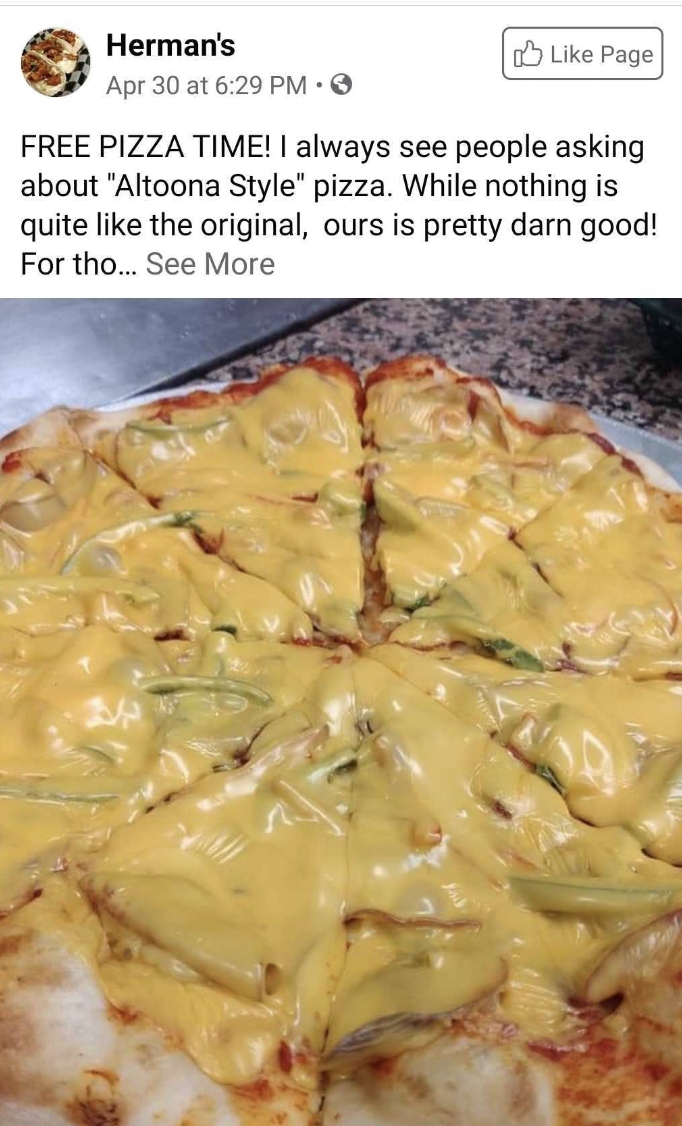
Quick backstory: Altoona is the home to Penn State Altoona, one of the school’s “commonwealth campuses.” You’ve probably heard of the University Park campus, but of the 73,000 or so of the non-online undergraduate students in the school’s system, 27,100 of them attend commonwealth campuses, with Altoona being the fourth largest among them.
I was one such student, spending two years in Altoona before making the trek to University Park. So you can imagine my surprise when I heard Altoona had its own regional pizza that 1) I’d never encountered, and 2) looked like a punishment from a wrathful god. A quick Google search confirmed this was A Thing, so I took a screenshot of the first picture I could find and tweeted this out.
i spent two years at penn state altoona and at no point do i recall hearing the phrase “altoona style pizza” pic.twitter.com/kjVZtJVktW
— Bill DiFilippo (@billdifilippo) May 4, 2020
The next two days made me laugh a lot. Seemingly everyone who had ever known someone from Altoona was getting tagged by friends demanding an explanation. Some people who were born and raised in or around Toon Town swore that they’d never heard of it. A pair of friends who grew up in the area were flummoxed as to how this ostensibly regional delicacy that they’d never heard of could possibly be real. Curious, they asked their respective moms about it. Both confirmed the distinctive pie’s place in the pizza firmament.
According to an absolutely wonderful piece done by Ryan Deto of Pittsburgh City Paper and a whole lot of folks on Twitter, the now-former Altoona Hotel was the birthplace of the pie. One Pennsylvanian seems to confirm my personal hunch: it was born out of the desire for pizza by the area’s Italian immigrants, who could not always get what they needed to make a classic pie. A true case of necessity being the mother of invention.
Once this started to pick up, I figured I had to try it. The issue is there is a pandemic going on right now and I cannot get to Altoona (in case you hadn’t heard). But I do have an oven, a sheet tray, and the ability to go to a grocery store. So I decided to step into the kitchen to make a pizza featuring one of the weirdest meat, cheese, and veggie mixtures ever to hit a pie.
In order to be completely thorough, I decided to undertake this experiment three ways. The first two pizzas I made were the standard Altoona pies — green peppers, salami, cheese — but since there was disagreement over whether yellow American or Velveeta was called for, I decided to do both. The third was to do the Binging with Babish thing where I attempted to keep the spirit of the dish but make it, uh, less weird.
The good news is that picking up the necessary items was pretty easy. I cut one corner — Wegman’s has pre-made pizza dough that works in a pinch, especially when you’re like me and don’t always have the time to dedicate to making your own dough. Most other ingredients in play were easy to find in every supermarket — packaged and sliced salami, the two kinds of cheese, and green bell peppers.
As penance for taking the easy way out with the dough, I made my own sauce. This is the easiest thing on earth — some garlic in some warmed up olive oil, dump in a can of tomatoes, season with salt, pepper, red pepper flakes, and Italian seasoning. My last name ends with an O, so you can trust me when I say this takes like 10 minutes and is better than anything you’d get from a jar. It was specified that this is a sweet tomato sauce, so I added a bit of sugar, too.
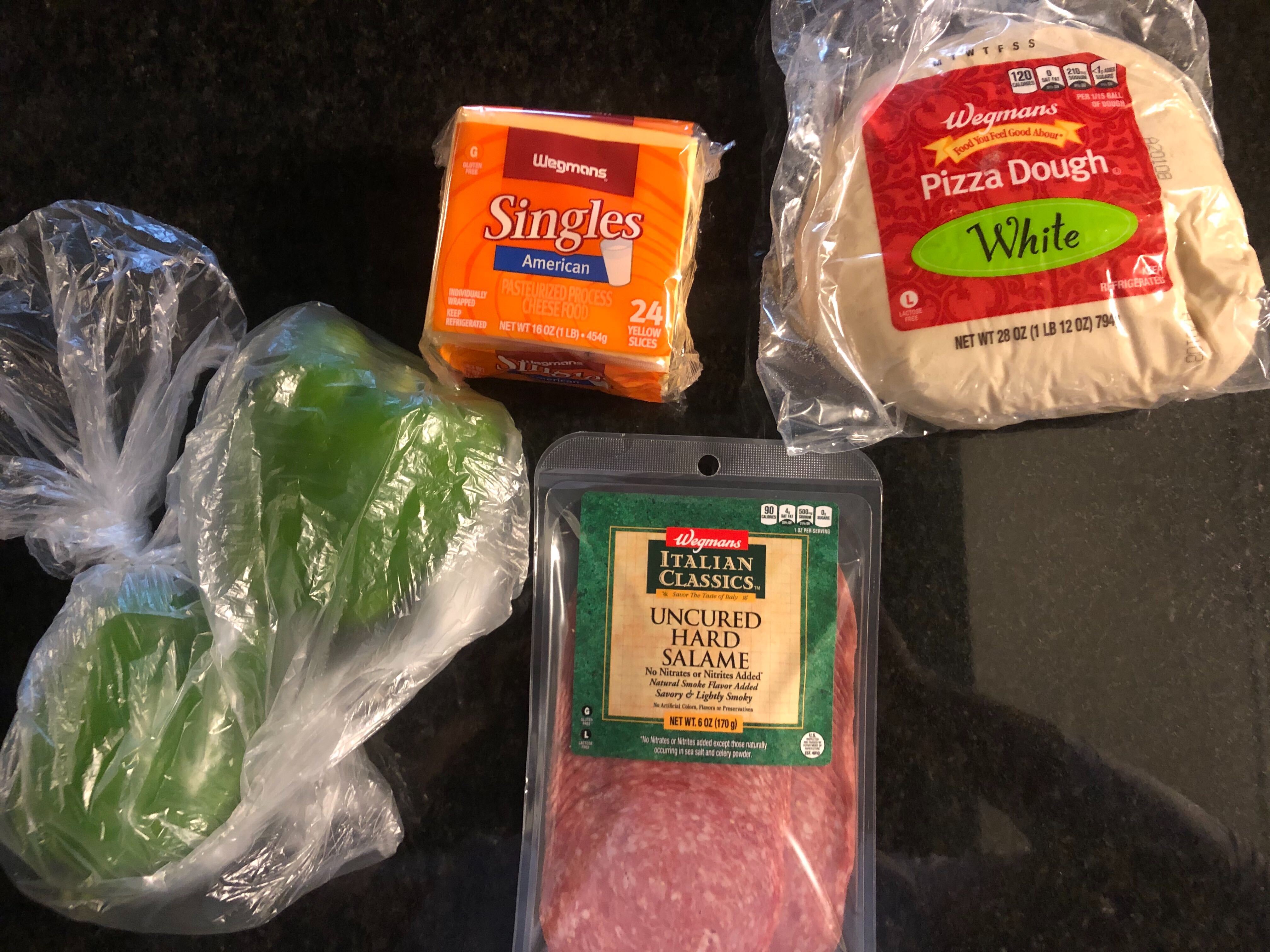
For the assembly, I decided to do two personal pizzas, because I am one human (albeit one with a healthy appetite) and my hunch was that one bite was all I really needed of these monstrosities. Per this Facebook post a friend showed me, the layering goes sauce, then salami, then uncooked peppers, then cheese. Behold:
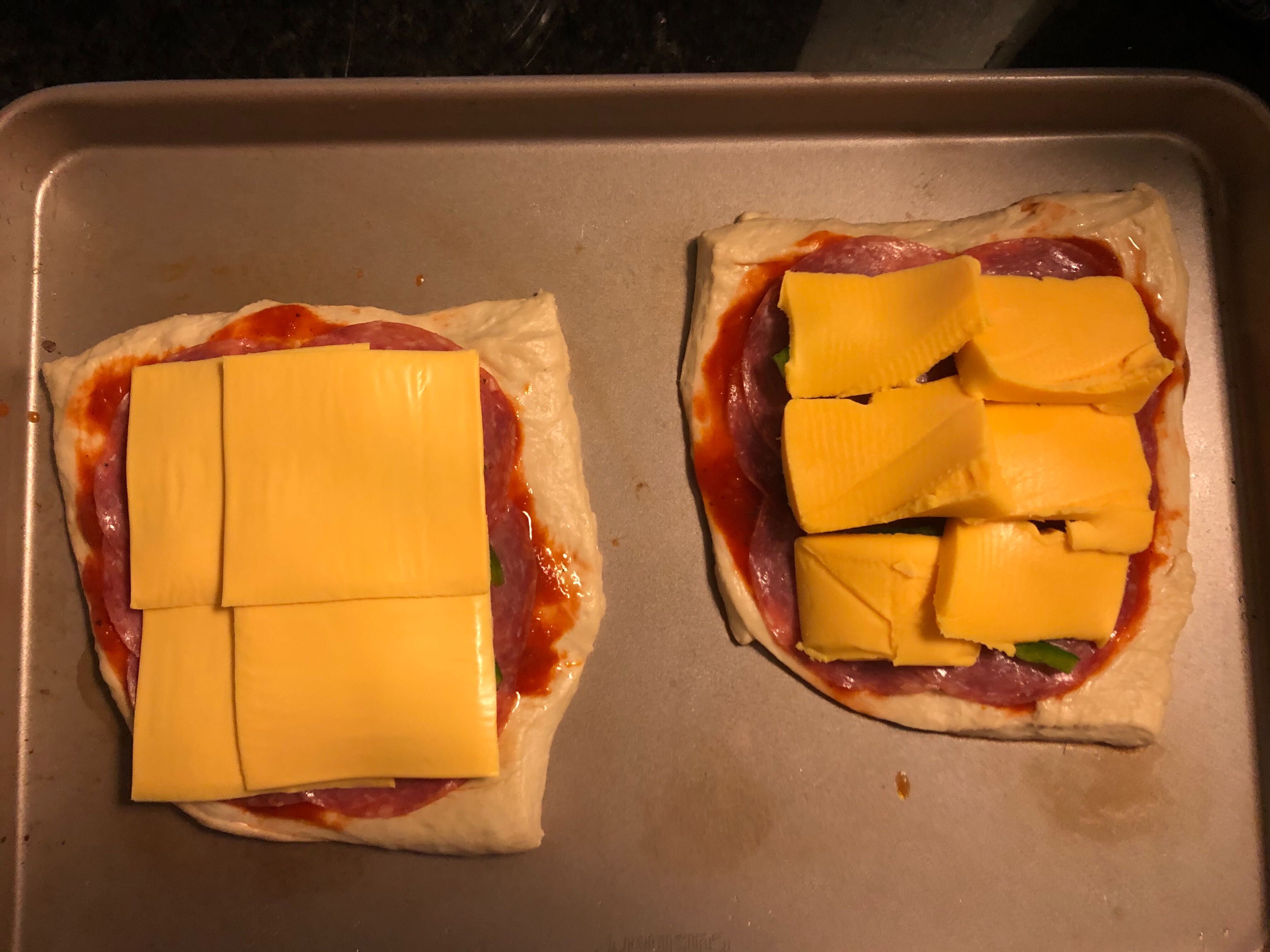
Despite liking, individually, everything on this pie, it’s a brutal image. Like a frame from a montage made by Mother Nature, urging us to change our ways. Here is what they look like after 20 minutes at 400 degrees.
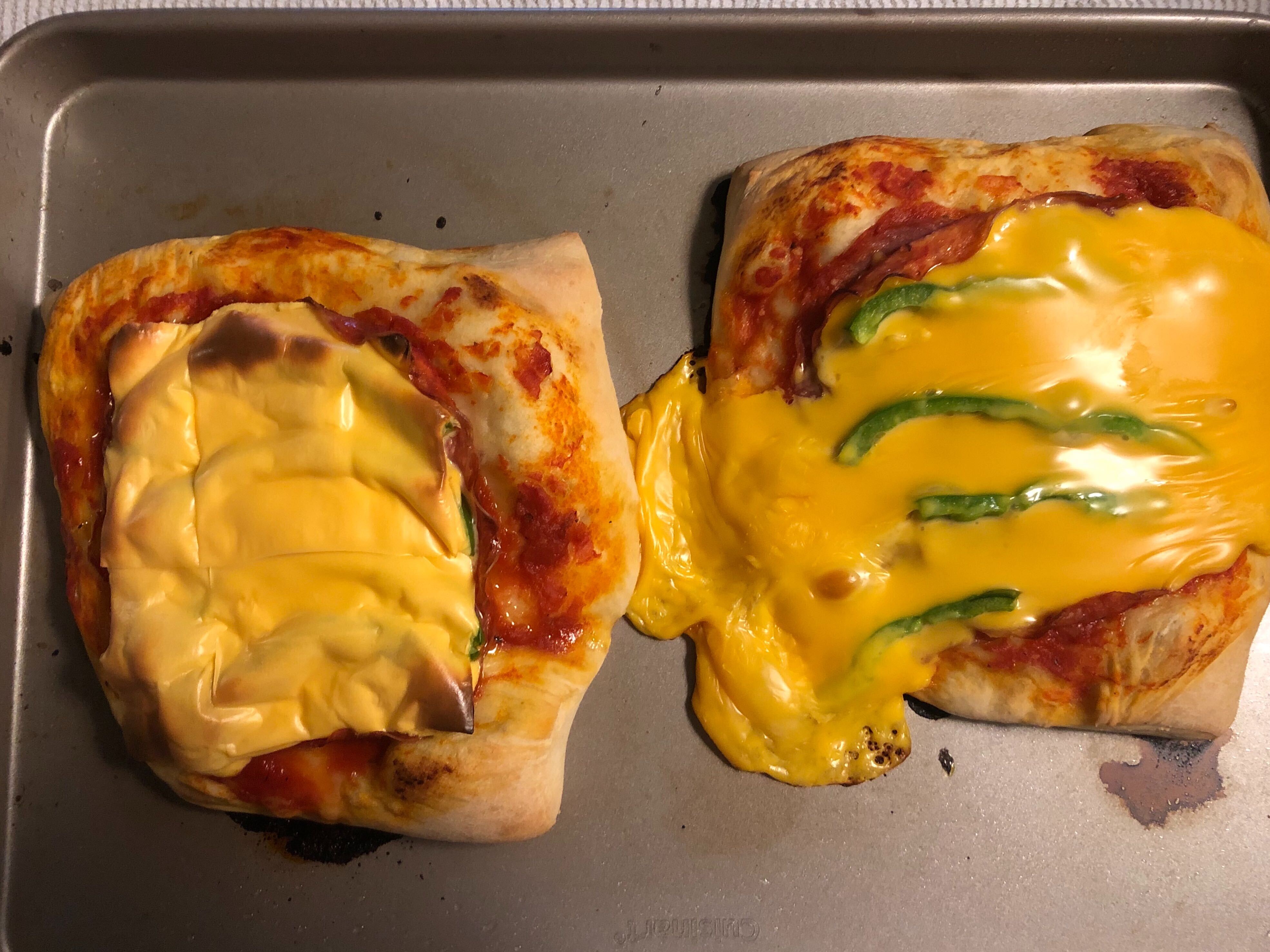
I, as you can surely tell, messed up the rolling out the dough portion of this and got these weird mondo pies where certain corners were thoroughly cooked while others were not, in part because the cheese to everything else ratio was just off. Still, I was able to get a few bites of both pies where everything sat together on completely cooked crust. It wasn’t bad, necessarily, it just tasted like what would happen if Subway made pizza. There are times when a person wants that, maybe. And I can absolutely see how this regional branch of the pizza family tree could be born out of the needs of Italian immigrants.
Still, raw strips of green bell peppers don’t quite cook up when hidden under cheese, the Velveeta just doesn’t work, and the salami needed some crisp edges and to not be in such gigantic pieces. But I figured there must be a path in which all of these ingredients could be used to make something legitimately solid. They’re all good-tasting things, after all.
Then it hit me. The answer is in Pennsylvania, but we have to leave Altoona in order to find it. In a phrase that also applied to Allen Iverson from the summer of 1996 through early 2007 — the answer is in Philadelphia. Cheesesteaks have meat, cheese, and potentially peppers of some sort on them. Traveling a stone’s throw north from Philly, we get to Lehigh Valley, which puts a sweet red sauce on its cheesesteaks. There’s some controversy over this, as you may imagine, but I asked my friend Ted, who is from that area, about whether this is a regional thing, and he promptly replied: “it’s delicious.”
I decided I could work with the cheesesteak approach and reverse engineer a pizza from there. I kept the sauce the same, and because it can be good on cheesesteaks, used the same yellow American (I am a provolone guy when it comes to cheesesteaks, but that’s neither here nor there). The peppers being uncooked before going on the pizza had to be fixed, and to make this more cheesesteak friendly, I diced them and cooked them up with some onions. For the meat, I prepared some shaved steak, then tossed the salami in and got it nice and crispy.
The result, before and after 25 minutes and 450 degrees:
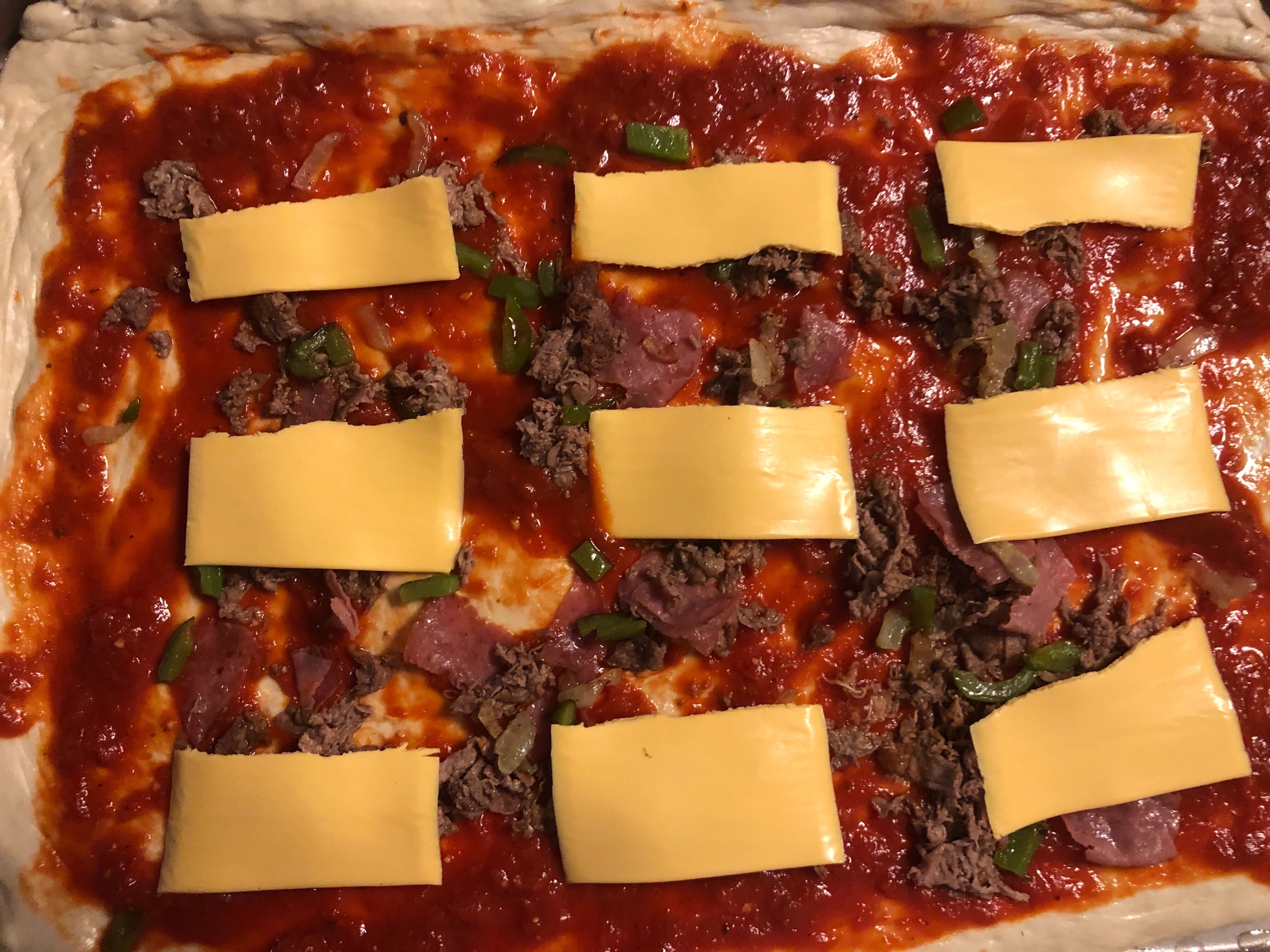
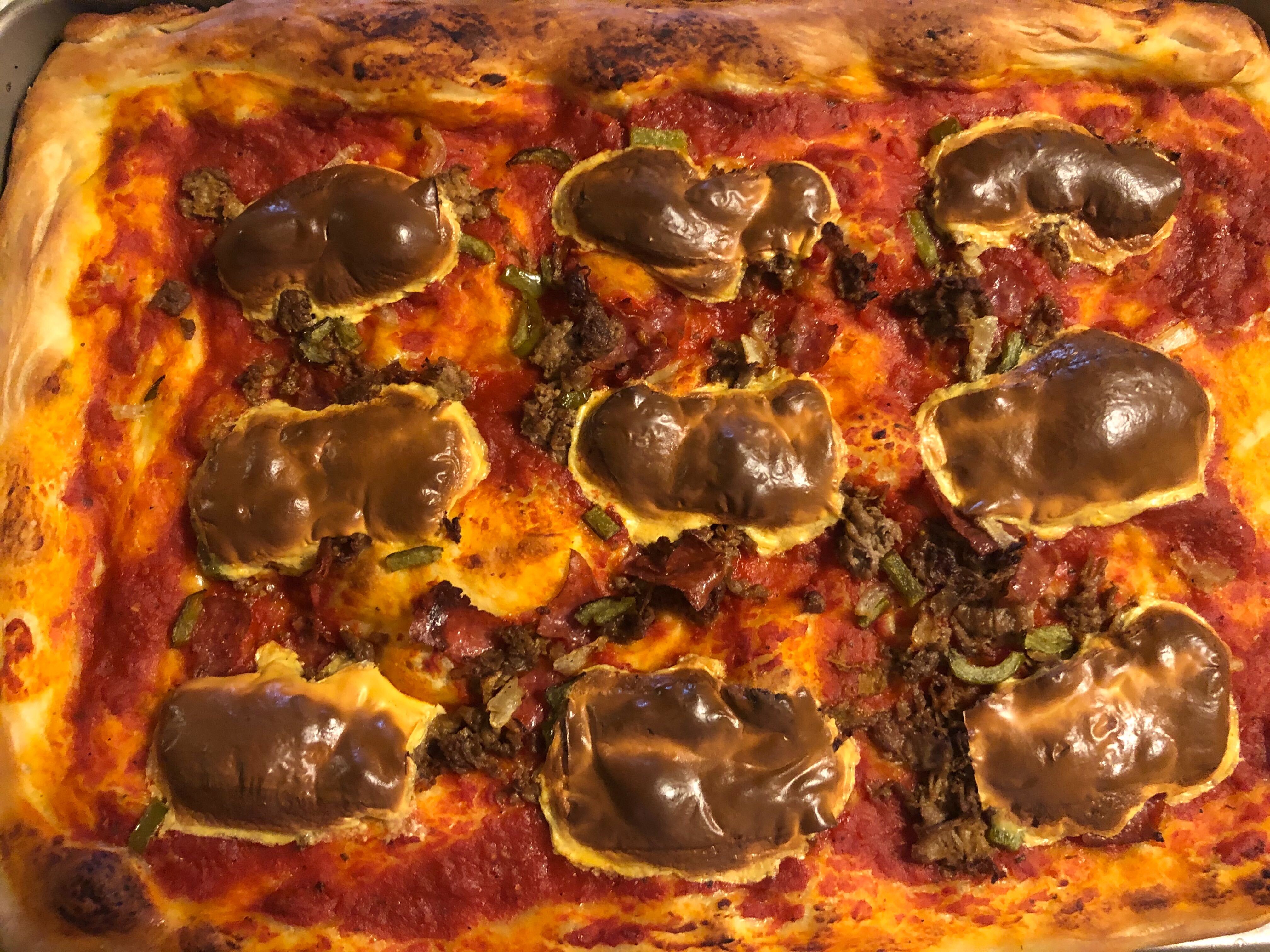
It certainly looked a little better, even if the cheese looks like a bunch of weird scabs on the surface of the pizza. The taste was better, too: the steak and onions were welcome additions, with the steak serving as a good balance to the salami and the onions providing some sweetness and rounding out the dish. The cheese is still a problem, particularly because longer exposure to high heat is not something that works for processed American cheese. But between the add-ons and pre-cooking the peppers and salami, this was legitimately kinda tasty.
Trust me, I was just as stunned as you are.
One question remains after all this: Should you make and eat either of these? The answer is, of course, no. But if you insist on making one, you should absolutely make the original version. If there’s one thing we are learning amid the COVID-19 pandemic, it’s that you only have so many opportunities to try and experience weird, quirky, interesting things. Life is fleeting. Death stalks us all.
Why not, then, make a dish that harkens back to a different era in a little Pennsylvanian city that you’ve never heard of? It’s a unique thing that you can experience while we’re all locked inside, bogged down by monotony and driven to distraction. If there’s ever a time to try a totally out of left field thing in the confines of your home or apartment, it’s now.
